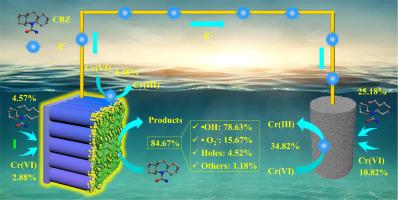Chemical Engineering Journal ( IF 13.3 ) Pub Date : 2020-10-30 , DOI: 10.1016/j.cej.2020.127571 Jun Cui , Yuansheng Pei , Jiaqi Hou , Yiming Zheng , Yu Zhang , Kunhao Wei , Xiaosong He , Beidou Xi

|
Photocatalytic electrode materials commonly exhibit limited degradation of organic pollutants and toxic metal reduction owing to the low separation efficiency of the electron-hole pair. To enhance the photocatalytic activity, a visible-light-driven Z-scheme TiO2-carbon dots-polyaniline (PANI) photocatalytic electrode was fabricated. After co-decorating with carbon dots and PANI, the light adsorption capability was improved, the bandgap was narrowed by 0.4 eV, the photocurrent density increased by 18.8 times under visible-light excitation and 9.5 times at a bias of 0.95 VRHE, resulting in good simultaneous carbamazepine degradation (44.67%) and Cr(VI) reduction (11.94%) performance. Three photoelectrochemical (PEC) systems were then constructed to further strengthen the water purification performance of the photocatalytic electrode. The simultaneous carbamazepine degradation and Cr(VI) reduction performances were further enhanced to 77.63%-83.29% and 23.70%-25.68%, respectively. The good carbamazepine degradation was attributed to the radical process (•OH, 78.63%). Dehydration, hydrolysis, deaminisation, de-ketonisation, and ring-opened reactions were directly responsible for the decomposition and mineralization of CBZ.
中文翻译:

基于碳点的Z方案光催化电极的构建,该电极具有增强的可见光驱动活性,可用于不同反应体系中的Cr(VI)还原和卡马西平降解
由于电子-空穴对的低分离效率,光催化电极材料通常表现出有限的有机污染物降解和有毒金属还原。为了增强光催化活性,制备了可见光驱动的Z-方案TiO 2-碳点-聚苯胺(PANI)光催化电极。与碳点和PANI共同装饰后,光吸收能力提高,带隙缩小0.4 eV,可见光激发下光电流密度增加18.8倍,偏压为0.95 V RHE时光电流密度增加9.5倍,可同时导致良好的卡马西平降解(44.67%)和Cr(VI)还原(11.94%)性能。然后构建了三个光电化学(PEC)系统,以进一步增强光催化电极的水净化性能。卡马西平的同时降解性能和Cr(VI)还原性能分别进一步提高到77.63%-83.29%和23.70%-25.68%。卡马西平的良好降解归因于自由基过程(•OH,78.63%)。脱水,水解,脱氨,去酮化和开环反应是CBZ分解和矿化的直接原因。











































 京公网安备 11010802027423号
京公网安备 11010802027423号